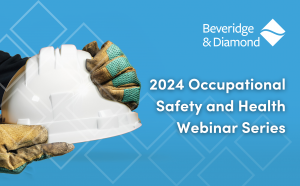Cal/OSHA Adopts Non-Emergency COVID-19 Regulation
After several rounds of revisions and contentious public meetings, the Cal/OSHA Standards Board adopted the agency’s proposed non-emergency regulatory standard for COVID-19 on December 15. The new standard extends many of the requirements already in place under the Emergency Temporary Standard (ETS) with several notable modifications. Most provisions of the non-emergency standard will be in effect for two years after the effective date, although the recordkeeping provisions will remain in effect for three years. As a result, California employers will continue to face significant COVID-19 requirements in the workplace for an extended period.
Employers should be aware of the following changes:
- COVID-19 Notice Requirements Aligned with AB 2693: The permanent standard incorporates by reference Labor Code Section 6409.6 (as amended by AB 2693), which extends California’s statutory COVID-19 notice provisions until January 1, 2024, and allows employers to issue positive case notifications through an online dashboard rather than through direct employee communications. Employers who utilize the online portal option must keep a record of when they post the notices and meet statutory requirements for including required information.
- Outbreak Reporting Requirements Adjusted: Also consistent with AB 2693, employers are no longer required to report non-major outbreaks (currently defined as three or more COVID-19 cases in an exposed group over 14 days) to local health departments under the permanent standard. However, the permanent standard adds a new Cal/OSHA reporting requirement for major outbreaks (currently defined as 20 or more COVID-19 cases in an exposed group over 30 days). This is a new state-level reporting requirement, and Cal/OSHA has not yet established a portal or other details on how such reports will need to be submitted. The permanent standard also allows the California Department of Public Health (CDPH) to issue alternative thresholds for outbreaks, which could reduce the burden on employers if CDPH decides to set a higher bar for triggering outbreak status.
- Separate COVID-19 Plan Not Required: Employers are now permitted to address COVID-19 as a workplace hazard under their Injury and Illness Prevention Program (IIPP). However, maintaining a standalone plan is still allowed if preferred.
- Close Contacts Definition Clarified: The permanent standard aligns with CDPH guidance to define “close contact” in part based on the size of the relevant indoor space. For indoor spaces of 400,000 or fewer cubic feet per floor, “close contact” is now defined as “sharing the same indoor airspace” with a COVID-19 case for a cumulative total of 15 minutes or more over a 24-hour period during the COVID-19 case’s infectious period. For many employers, this new definition will be harder to operationalize, resulting in larger numbers of close contacts within the workplace. In indoor spaces greater than 400,000 cubic feet, employers are allowed to use the more concrete metric of physical distancing: in such large spaces, the permanent standard defines close contacts as being within six feet of a positive case over the same period.
- Returned Case Exemption Reduced: A “returned case” is a COVID-19 case who was excluded from work but returned and did not develop any COVID-19 symptoms after returning. The permanent standard reduces the time period that a person is considered a returned case from 90 days to 30 days after the initial onset of COVID-19 symptoms, or 30 days after the first positive test if the person never developed symptoms.
- Exclusion Pay Requirement Eliminated: Employers are no longer required to pay employees who have been excluded from work.
Looking Ahead
The ETS will remain in effect while the Office of Administrative Law (OAL) reviews the non-emergency standard. OAL has 30 business days to complete its review and must complete the process by early February. Once approved, the standard will replace the ETS and remain in effect for two years.
Beveridge & Diamond’s Occupational Health & Safety practice assists clients with federal and state OSHA standards and regulations that govern worker health and safety. Our work includes overseeing compliance audits and risk assessments, reviewing company policies and procedures, conducting internal trainings, responding to information requests, and representing companies during workplace incidents, federal and state OSHA inspections, and related enforcement. With an office in California, our team includes lawyers with experience with Cal/OSHA regulations specifically. For more information, please contact the authors.









